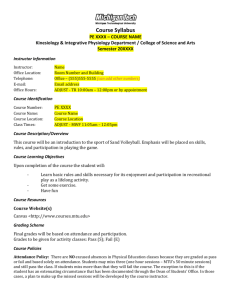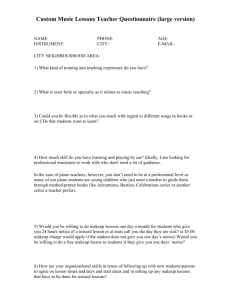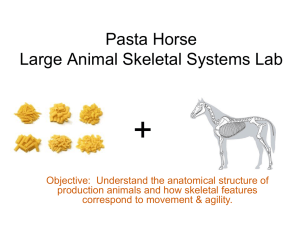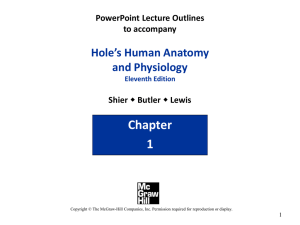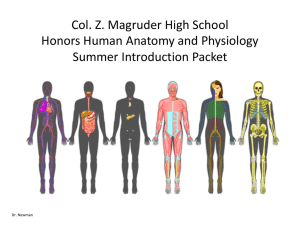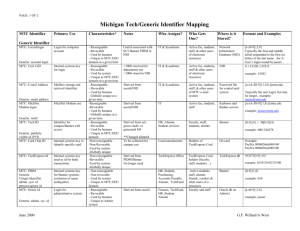MISSISSIPPI GULF COAST COMMUNITY COLLEGE
advertisement
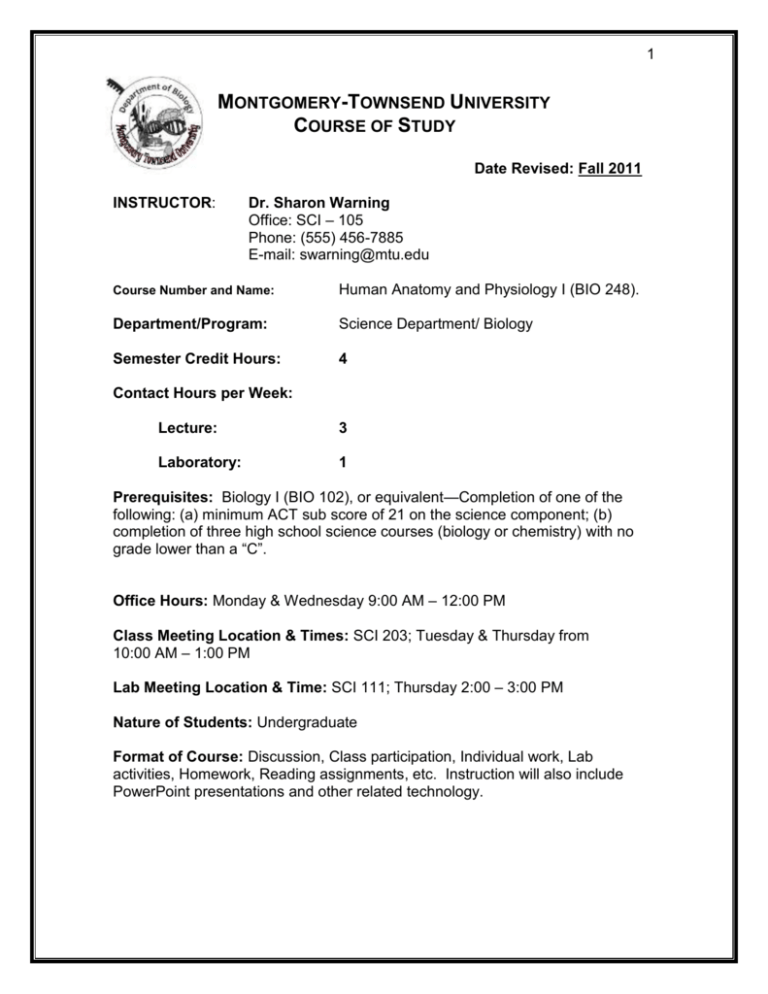
1 MONTGOMERY-TOWNSEND UNIVERSITY COURSE OF STUDY Date Revised: Fall 2011 INSTRUCTOR: Dr. Sharon Warning Office: SCI – 105 Phone: (555) 456-7885 E-mail: swarning@mtu.edu Course Number and Name: Human Anatomy and Physiology I (BIO 248). Department/Program: Science Department/ Biology Semester Credit Hours: 4 Contact Hours per Week: Lecture: 3 Laboratory: 1 Prerequisites: Biology I (BIO 102), or equivalent—Completion of one of the following: (a) minimum ACT sub score of 21 on the science component; (b) completion of three high school science courses (biology or chemistry) with no grade lower than a “C”. Office Hours: Monday & Wednesday 9:00 AM – 12:00 PM Class Meeting Location & Times: SCI 203; Tuesday & Thursday from 10:00 AM – 1:00 PM Lab Meeting Location & Time: SCI 111; Thursday 2:00 – 3:00 PM Nature of Students: Undergraduate Format of Course: Discussion, Class participation, Individual work, Lab activities, Homework, Reading assignments, etc. Instruction will also include PowerPoint presentations and other related technology. 2 COURSE DESCRIPTION: A combined lecture and laboratory course that includes the study of anatomy and physiology of the human body as an integrated whole with detailed studies of the integumentary, skeletal, muscular, and nervous systems. Labs associated with this course contain experiments and exercises that reinforce the principles introduced in lecture classes. CATALOG DESCRIPTION: BIO 248. Anatomy and Physiology I: (4 hours) A general study of the anatomy and physiology of the cells, tissues, integumentary, skeletal, and muscular systems of the human body, along with basic human genetics. A one semester hour laboratory experience is included. STUDENT LEARNING OUTCOMES: Upon successful completion of this course, the student will be able to: 1. review basic functions at the cellular level to include transport, organelle physiology, and cell division. 2. explain the types and functions of tissues. 3. outline the structure and physiology of the integumentary system. 4. present the axial and appendicular skeletal systems, components, and articulations. 5. examine the muscular system histologically, developmentally, and functionally. 6. describe the central and peripheral nervous systems, their histologies, anatomical features, and conduction pathways. 7. explore the special senses (eyes, ears, nose, taste, and equilibrium). Textbook: (required) Principles of Anatomy and Physiology, Tortora & Derrickson. Lab Manual: A Guide to Anatomy & Physiology Lab, Rust. (optional) REQUIRED ITEMS: SCANTRON answer sheets number 2 pencils Loose-leaf paper binder for notes 3 RULES AND REGULATIONS: 1. Regular attendance in class and the laboratory periods is necessary. Be on time for each class and lab session. 2. You are encouraged to actively participate in the class sessions. Your appropriate comments and observations will enhance the learning experience. 3. Record notes, observations, and other information covered in class in appropriate binders. 4. You are expected to come to class prepared with assigned readings from the textbook and other assigned references. 5. Review your class and lab material frequently. Begin studying well in advance for all tests. 6. Course work will involve other activities such as reading assignments, reports, and special lab activities. 7. Turn your cell phone on silent while in class and no texting. WEB SITE: The textbook's web site provides many resources for study, review, as well as links to a number of related sites. Because the web site address is subject to frequent change, the instructor will provide instructions regarding the most current address. COURSE EVALUATION: Tests will consist of a variety of questions multiple choice, matching, true-false, essay, fill in the blank. The format for laboratory testing will involve naming specific structures on anatomical specimens or identifying the functions associated with these structures. TESTING: There will be a total of nine tests for this course, including a comprehensive final exam and a lab final. Students will be expected to take all tests at the scheduled times. Should an officially recognized absence occur on a day during which a test is scheduled, that student will be allowed to take a makeup on the appropriate makeup date. Extra credit options are not allowed for makeup tests. PROJECTS: There will be one project that will be graded by a rubric. It involves research and a presentation. A rubric will be provided. 4 LABS: Weekly lab activities will be conducted and graded. These grades will average together to make one additional test grade. You will be allowed two drop grades for lab. If you are absent, that counts as a drop grade. There are no makeup labs. INSTRUCTIONAL METHODS: Instructional methods will include lectures with marker board, overhead projections, laboratory dissections, microscopic observations, and multimedia presentations. A & P I SEMESTER CONTENT OUTLINE Week Chapter 1 Topic (Time Projections are Approximate) Course Introduction 1 An Introduction to the Human Body TEST 1 2 4 The Tissue Level of Organization 3 5 The Integumentary System TEST 2 4 5 6 7 The Skeletal System: Bone Tissue The Skeletal System: The Axial Skeletal System TEST 3 6 8 The Skeletal System: The Appendicular Skeletal System Projects Due – Begin Presentations 7 9 Joints TEST 4 8 10 Muscular Tissue Continue Presentations 9 11 The Muscular System TEST 5 10 12 Nervous Tissue Continue Presentations 5 11 13 The Spinal Cord and Spinal Nerves TEST 6 12 14 The Brain and Cranial Nerves Complete Presentations 13 16 Sensory, Motor, and Integrative Systems TEST 7 14 17 Special Senses--Smell and Taste 15 17 Special Senses--Eye 16 17 17 Special Senses--Ear FINAL EXAM AND LAB FINAL Article Critique and Presentation: Students will be assigned a topic to research and present. The topics will reemphasize concepts presented in class. A rubric is provided to help you prepare for this assignment. Due: Thursday, Week 6 Begin project presentations week 6 and complete presentations by week 12. The requirements for the research paper are as follows: You will be assigned a topic from the text to present to the class. To supplement the information in the text, you are to choose a minimum of 3 relevant articles about your topic. The paper should be 3-4 pages long. This does not include the cover page or the reference page. The article must be scholarly, published no earlier than 2000. The paper must follow APA guidelines for citing and referencing the article. Margins are to be 1-inch top, bottom, and sides. Use Times Roman 12-point font. The requirements for the presentation are as follows: You are to create a PowerPoint presentation to demonstrate your findings. The presentation should last between 4 to 7 minutes. You are to include at least 3 relevant visual aids to support your topic. 6 Name: __________________________ Topic: ___________________________ _________ Student can locate information on a particular subject. Student can give source information for article. Student provides a visual aid. Beginning 1 Student has less than the 3 required articles. Articles are not relevant. Paper is not the required 3-4 pages. Student has articles, but does not provide source information. Student has one of the three required visual aids. Student presents the information to the class in the form of an oral presentation. Student is off topic and presentation is less or more than 4-7 minutes. Student exemplifies knowledge of the material. Student expresses no knowledge of the material. Time: Start __________ Finish Developing 2 Student has the 3 required articles and the paper is the right length. Articles are relevant, but very short and lacking in detail. Student has two of the three required visual aids. Student presentation is on topic, but is less or more than 4-7 minutes. Student reads the whole presentation directly from note cards or PowerPoint. Accomplished 3 Student has the 3 required articles and the paper is the right length. Articles are relevant, but not detailed. Exemplary 4 The 3 academic articles are relevant to the topic and detailed about the topic of paper. The paper is the proper length. Student gives source information for articles, but not in requested format. Student has all three required visual aids, but one or more are not relevant. Student presentation is on topic, 4-7 minutes, but student is unprofessional. Student gives citation information in APA format. Student reads less than half of the presentation from note cards or PowerPoint. Student presents the presentation without reading from note cards or PowerPoint. Score Student has all three required visual aids and all visual aids are relevant. Student presentation is on topic, 4-7 minutes, and student is professional. *Note: The research paper is due ON THE DAY YOU PRESENT. If you do not have them on the day you present, then you will lose credit for them. You MAY NOT turn them in late. Total Score: ________ X 5 = ________________ (Grade) How to locate an academic article: Step One: Go to www.mtu.edu Step Two: Click on the libraries link Step Three: Click on Magnolia Project Step Four: Click on Biological Surveys Step Five: Both Academic Search Premier or Healthsource are good databases Step Six: When searching, be sure to click the box for full text and peer reviewed 7 Note: If you are trying to access this from a computer that is not on campus, you will need a username: magn0120 GRADING: Grades and evaluations will be made using the following criteria: 10 % Quizzes & Daily Grades: lecture worksheets, assignments, &/or practice tests 70 % Tests: lecture, lab, and comprehensive final 20 % Lab Assignments and Project Course Grade Scale: 90-100 = A; 80-89 = B; 70-79 = C; 60-69 = D; 59 and below = F INSTRUCTIONS FOR ADDITIONAL ASSISTANCE: Students needing assistance should make an appointment with the Instructor utilize the learning center located in student support services. REASONABLE ACCOMMODATIONS: If a student has a disability of any kind that requires assistance or reasonable accommodations in the classroom or laboratory, see the instructor as soon as possible then see the office of Americans with Disabilities Act, Dr. Barty Watts, at (555) 456-1000.) ACADEMIC INTEGRITY: Every MTU student is expected to uphold the policies and procedures as defined in the student code of conduct and the University’s Policies and Procedures manual. A full explanation of the policies is available in the student handbook and online. Students are expected to read and familiarize themselves with all policies and procedures as related to academic integrity at MTU. Failure to adhere to these policies and procedures is considered a serious violation of MTU’s Academic Integrity Policy and will result in review by the student judiciary board as stated in the student handbook. MISSION STATEMENT: Montgomery Townsend University strives to cultivate discovery, expansion, transmission, and application of knowledge in an array of scholarly and professional disciplines. Its duty of delivering superior quality undergraduate and graduate programs is indivisible from its task of creating new understandings through experimentation and ingenuity. Montgomery Townsend University prepares students for roles in leadership, responsibility, and service to the community. The institution supports freedom of inquiry and a collegial environment fostering the development of the human mind and soul. It welcomes and seeks to serve a progressively diverse population in a global economy. While being guided by our mission, Montgomery Townsend University seeks to maintain its reputation as a competitive and respected institution of higher learning. 8 ATTENDANCE POLICY: Attendance at all class meetings and labs in expected. Students may not miss more than 25% of class. This means no more than two lecture classes may be missed and no more than two lab classes may be missed. Any student who misses more than the maximum 25% of class will not receive credit. Students are excused from class only if the absence is deemed excused by the Dean of Student Services. Tardies of more than 15 minutes will result in an absence. Two tardies of less than 15 minutes will result in one absence. Leaving class more than 15 minutes early will result in an absence. Leaving class twice, less than 15 minutes early, will result in one absence. LAB ATTENDANCE POLICY: There is no option for making up missed labs; therefore, attendance is critical. If you miss a lab, your grade will be a zero! Two missed labs will result in the removal from course. MAKE-UP POLICY: Students are encouraged to not miss test days. If an exam is missed, it is the student’s responsibility to contact and make arrangements with the instructor. The student is responsible for making up a missed exam within one week of the given test date. Failure to make up an exam will result in a zero. The student has the opportunity to make-up only one exam regardless of how many are missed. Permission to make up an exam is at the instructor’s discretion. Bonus point opportunities will not be on make-up exams. DISASTER PLAN: Class closure due to emergencies or disasters will be made up according to the MTU’s Natural Disaster Policy. Information regarding closures will be posted on MTU’s website: www.mtu.edu, as well as sent via media alerts. If possible, check BlackBoard postings for makeup assignment dates and times. Instructions for accessing BlackBoard can be found on the MTU homepage. TOBACCO-FREE: MTU’s campus is tobacco-free. Failure to abide by this policy will result in disciplinary action. LECTURE RECORDING: Students are permitted and encouraged to record lectures electronically by tape recorders, cellular devices, or other methods. This has proven to be highly effective toward improving class performance. Montgomery-Townsend University is an Equal Opportunity Employer and welcomes students and employees without regard to race, color, religion, national origin, sex, age, or qualified disability.
